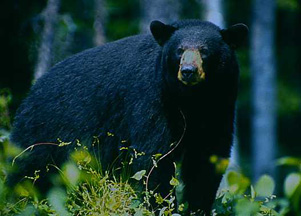
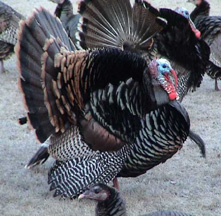


 The Accurate Reloading Forums
The Accurate Reloading Forums  THE ACCURATE RELOADING.COM FORUMS
THE ACCURATE RELOADING.COM FORUMS  Hunting
Hunting  American Big Game Hunting
American Big Game Hunting  how big?
how big?Go  | New  | Find  | Notify  | Tools  | Reply  |  |
one of us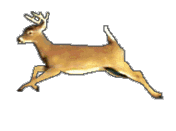 |
http://www.fieldandstream.com/...me-farm?cmpid=021110 ****************************************************************** SI VIS PACEM PARA BELLUM *********** | ||
|
| one of us |
I wonder if one that big is any good to eat? If he is fat, should have some nice marbleing. | |||
|
| One of Us |
I wonder if the buck has any nuts? I've heard of game ranches castrating fawns to get them to grow big just like steers. | |||
|
one of us |
he's got antlers,so he must have nuts. ****************************************************************** SI VIS PACEM PARA BELLUM *********** | |||
|
| One of Us |
I might be wrong but I don't believe that not having nuts would mean that it wouldn't have antlers. | |||
|
| One of Us |
Correct,they are called Stags.I saw one in a taxidermists shop in Miles City one year.It was shot In November and still was in Velvet | |||
|
one of us |
this one isnt in velvet.It is one big sumbitch,I will say that.  ****************************************************************** SI VIS PACEM PARA BELLUM *********** | |||
|
| One of Us |
I have heard of free ranging deer killed in Ohio going 350+ lbs, but not very many of them. Rad NRA Benefactor Member | |||
|
| One of Us |
You can see his nuts in the picture. Andy | |||
|
| one of us |
The body of the deer is grossly exaggerated by the use of an extreme wide angle lens, making it appear much larger than it actually is. I despise the use of wide angle for kill pictures, but it's what most folks use. In certain instances, yes, wide angle is useful, but if not used properly, it completely distorts proportions. The top 3 photos below were shot with longer lenses and maintain perspective. If I had my druthers, I'd rarely use anything shorter than 180mm (in 35mm format) for these type of photos, and many of mine have actually been taken with 300 and 400 mm. The bottom photo was taken with a super-wide (20mm) lens in 35mm format. Because the frame was kept reasonably level and the fact the antlers weren't the closest thing to the lens, their size is actually minimized while the front part of the face is exaggerated. Also note how much smaller the gun appears in the wide angle photo compared to the one taken with a tele. Now, I am not claiming these 2 were shot the same way, but I simply used them to illustate how wide angle influences perspective. Anyway, I'm sure you get the picture -- pardon the pun. 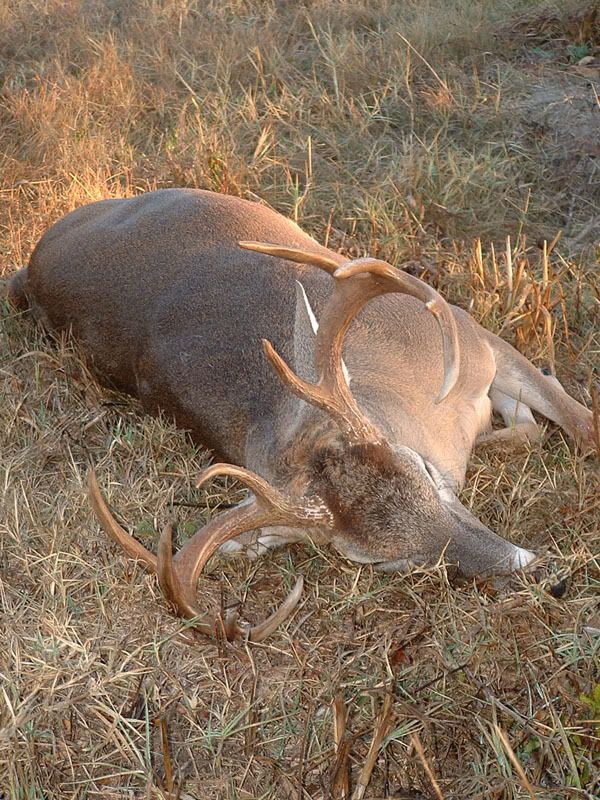 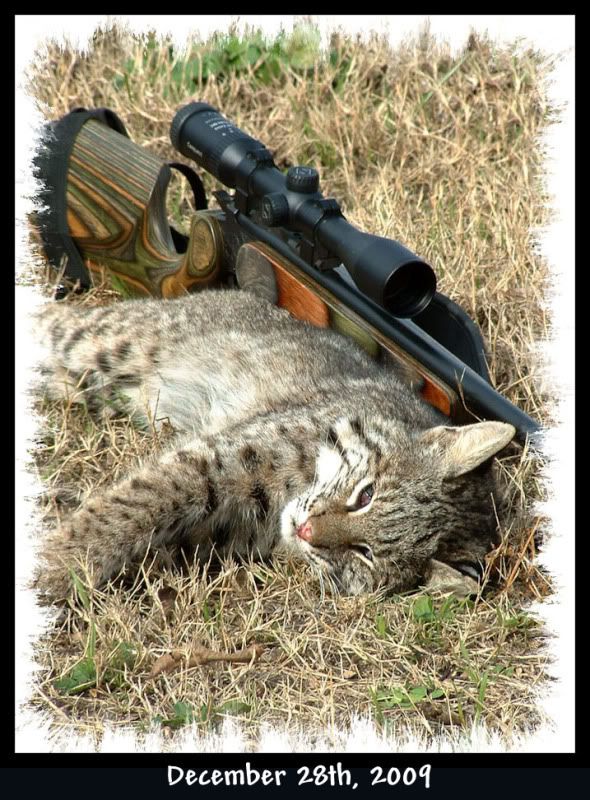 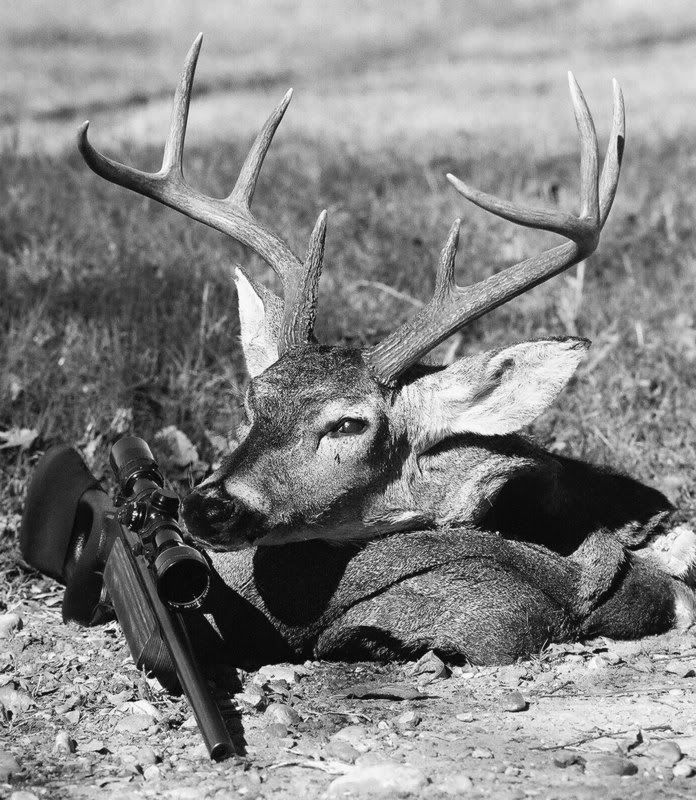 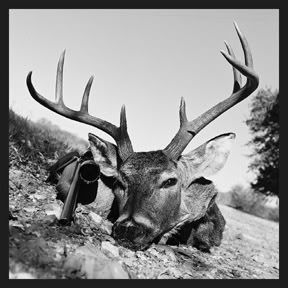 Bobby Μολὼν λαβέ The most important thing in life is not what we do but how and why we do it. - Nana Mouskouri | |||
|
| One of Us |
Bobby- while you are correct when you say that wide angle lenses can and do exaggerate the size of an animal that is not the end of the story. 1- What a wide angle lens does is bend the refracted light around the edges to an exaggerated degree. So in order to make the deer look bigger you need to place it in the foreground of the frame and it will be exaggerated larger in the context of the rest of the picture. Also note that the perspective will change as you get further back into the frame. Here is an example I found online notice how the butt of the deer is out of whack with the rest of the deer.(wide angle lens)  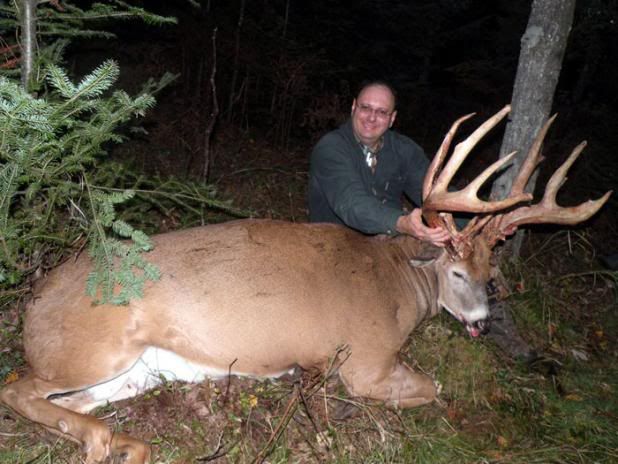 2-In this case of the WI 420lb game farm deer I do not believe that an "extreme wide angle" lens was used because if it was the deer's legs would appear huge being the closest foreground element. The deer's body would also get smaller as you went deeper into the frame. Also there would be the characteristic keystoning or bending of all straight lines on the edges of the frame. Now you might say the tree on the right looks bent but it looks to me to be on a hill and the tree on the left is perfectly straight and that would be impossible with an extreme wild angle lens. 3-While you are right about shorter lenses being able to exaggerate things bigger you should also keep in mind that longer lenses do the opposite they compress images. The human eye sees and equivalent of about a 50mm lens (in the 35 format) When you use a 300mm or 400mm you are compressing the image to an extreme amount. I typically use a 180 lens when I shoot a full body portrait of someone that I want to make look thinner. Now you may like the look you are getting with a 300mm. (it comes down to personal preference) I think that your 3rd shot is one of the best deer head shots I have ever seen. But I also think that the long lens compression compresses the length of the rifle. While this doesn't change to size of the deer head it does give the illusion of a really big head because the rifle looks so small and we all have a mental reference for how long a rifle is. 4- Finally we have to remember this is a 420lb deer. It was put on a scale and weighed. Is it a freak of nature-yes Was it possible that the game farm grew him with unnatural feed or hormones- Yes it's possible. But remember in my home state of MN right next door to WI where this deer was take there have been 2 documented cases of whitetail deer taken in the wild that were 500lbs! Some animals are just freaks. | |||
|
| One of Us |
At the turn of the 20th Century Deer in the 300 to 400 lb. range were shot quite often in Northern Wi.Big Virgin trees were clear cut and understory grew fast.The deer population exploded and there was little hunting pressure.They can get huge if you let them.Eagle River has a Museum with all kinds of big deer pics. | |||
|
| One of Us |
wetdog2084 you might be on to something here. Your post made me remember an article in the Minneapolis paper from 2006 about our last 500lb wild deer. It is too old for the link to still be active but I will cut and paste the story. Read down to the last part when the MN DNR checked his testicles... Article: MONSTER; A quarter-century ago, Minnesota's George Himango killed a buck - in fact, one of the biggest ever. Although he knew it was big, he didn't realize how big until he approached it after the kill.(SPORTS) Article from:Star Tribune (Minneapolis, MN) Article date:October 29, 2006 Author:Anderson, Dennis Copyright Twenty-five years ago, George Himango of Duluth did what no one other than Carl Lenander, also a Minnesotan, has done: He killed a white-tailed buck with an estimated live weight of more than 500 pounds. Field-dressed, Himango's deer weighed 402 pounds -- the exact weight assigned to the deer Lenander shot in 1925 near Isabella, Minn. The two deer far outweigh any other whitetails shot anywhere on the planet -- and perhaps their sizes never will be matched again. Here's how Himango, an Ojibwe who was raised on the Fond du Lac Indian Reservation just west of Duluth, recalls that deer and they day he shot it. Q Had you shot any really big deer before? A I shot one whose antlers scored 168. The body was nice, about 200-plus, dressed out. That's a big buck. But a deer's size can depend on what time of season he's weighed. If you get them early in the season, they'll weigh more. Later, they weigh less. Having said that, we never really weighed animals. The only reason we weighed this one was because it was so gigantic. We weighed it at the old IGA in Proctor. Q The day you killed your big buck, you were hunting on the Fond du Lac reservation, and your brother also shot a deer. A Yes, his was a nice buck. It might have been an 8-pointer. He shot his before mine, and I took its bladder out. We all spread its urine around our stands and utilized it as a cover scent. I also put some in a scrape I had identified near my stand. Q It was about 3 p.m. when you heard the buck approach. A Yes. It was a beautiful fall afternoon. All the worries of the world being lifted from your shoulders on a day like that, and suddenly you hear movement. He came from behind my left shoulder. I could hear him coming through the dry fallen leaves. A buck will drag his feet. In my experience, they move for about 20 yards and then stop. If they're confident, they'll move on. He was coming through the brush, and I could have taken a shot. I could have squeezed a shot off. But I certainly didn't want to wound an animal. So I kept following and following him. Then he stopped, and I couldn't see him. When he started to move again, he moved into the only corridor available for me to shoot. So I squeezed a shot off. His head was down, and I hit the brow tine on the left side. It drove the bullet right into his spine. Otherwise I think I would have missed him. Q Did he look big when you shot? A Not really. I mean, he looked like a big deer, because he held his antlers backwards. But I didn't think it was that huge. Q Then when you walked over to it ... A I'm a seasoned hunter. But when I saw it, I did a little hoop and holler and was dancing around the deer. My brother and cousin were hunting with me, and they had never heard me react that way when I shot a buck. Within a few minutes, they came over, and they, too, were unbelievably shocked. Q How'd you get it out? A We drug it. It couldn't have been a couple of football fields through the woods to our canoe. But it took us hours to move it. We had to clear a path so we could drag it. When we got it to my brother's deer, which weighed close to 180 or 190, field-dressed, it looked like a fawn. The only way we could get the deer into the canoe was to pull the canoe on shore and roll it in. Q When you weighed it, and it came in at 402 pounds, did you do call anyone or try to tell people? A No. We just weighed it and went home. I didn't realize the state or anyone kept records. And I couldn't enter it in any big buck contests. I had shot it during the tribal season, the day before the state's regular firearms season. We didn't want to inflame any problems among other hunters by saying we were successful. So we didn't seek any publicity. But it leaked out. Finally, the DNR came up and tried to verify things, and tried to understand why the animal was so big. Q And? A Well, the DNR guy wanted to see the entrails. He also wanted to see the hide. He also asked for the testicles. I hadn't even noticed, but they were little, like peanuts. He believed the deer might have been heifered when it was young, and had put weight on because of that. Genetically, obviously, it had the traits to make it big. But perhaps it was made bigger because of that. Q How did it taste? A The meat of this buck was marbled, just like bear meat. It was very good, and surprisingly tender. | |||
|
| One of Us |
That is a bogus photo. You cannot see testicles in op. Loss of testicles does not make an animal bigger, afterall they are a pretty good "implant" if you understand growth implants at all , as applied to cattle feeding. Dr.C At Home on the Range-Texas Panhandle | |||
|
one of us |
If Im not mistaken,deer antler development is stopped or interupted if their testes are damaged or removed. ****************************************************************** SI VIS PACEM PARA BELLUM *********** | |||
|
| one of us |
MN Hunter- I am keenly aware of what takes place with a wide angle as photography has been my livelihood for a long time now. I kept the ramblings short as few here would care to hear about the scientific aspect of it. Yes, that was a big deer. I am not refuting that. But it is clear to me that the photographer was standing and looking down onto the deer and that the belly of the deer was closer to the lens than the feet, hence the grossly exaggerated proportions (small feet, diminished neck and tiny head as compared to the rest of the body). My guess is that the photo was taken with a lens around the equivalent of 15-18mm in 35mm and certainly no less wide than a 20mm. Otherwise, either the deer weighed something on the order of 800 pounds or else the hunter in the photo was 3.5 ft tall and weighed all of 75 pounds. Also, when you wrote: "Also there would be the characteristic keystoning or bending of all straight lines on the edges of the frame, " I have to add that -- while you do have a valid point -- such is not completely true. Cheaper glass yields the fisheye effect easily; better optics minimize edge distortion, as will maintaining a relatively flat plane betwen subject and lens. But even if it occurs, today's programs largely correct such images -- another reason I still despise the digital world. (Some of the newer digis allow you to correct that in-camera.) Back in the day of film (and when photography was still an art), one would have to get it right in the camera and not correct all the wrongs later on in the computer lab. But that's another subject altogether... Bobby Μολὼν λαβέ The most important thing in life is not what we do but how and why we do it. - Nana Mouskouri | |||
|
| one of us |
MN Hunter: As to the mention that extreme wide angle would result in "keystoning or bending of all straight lines," here is a shot taken with a 17mm lens in 35mm: 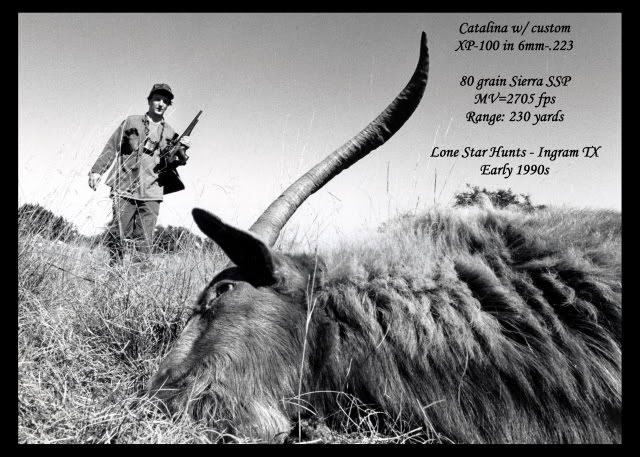 The plane was kept reasonably flat, and while the perspective is certainly out of proportion, the edges remain in relatively good order. This image was taken on b/w film a number of years ago, and this low-rez image is simply a scan of a small proof. And as to the buck photo, I would also wager that the final image had some cropping done as well, something else that removes edge distortion. Bobby Μολὼν λαβέ The most important thing in life is not what we do but how and why we do it. - Nana Mouskouri | |||
|
| One of Us |
There is a reason why farmers and ranchers castrate cattle hogs and sheep, it makes the animal put on weight faster and the animal will tend to grow bigger. Oxen are a good example of this, no nuts and they get quite big. I would assume that a castrated deer would not expend energy rutting and would maintain and gain more weight than a buck with his nuts attached. As far as antler growth and testicles are concerned I don't see what difference it would make. Cattle and sheep still grow horns after castration. I don't know if antlers would be any different. Maybe there is a vet lurking on AR that could answer the question. The point is somewhat moot since the deer in question obviously is all there. I brought up the nut question because I've heard of game ranches doing this and had a rancher near Benjamin TX tell me that the ranch hands would catch a few fawns each year and castrate them, he said that they would grow big. I thought that he was pulling my chain but he swore that it was true. who knows? If that buck was behind a fence the owners were probably feeding it some hot feed. Couple that with some camera tricks and presto. | |||
|
| One of Us |
No matter what camera took that picture, that deer is a hog! And if I were a middle aged bald fogey I'd probably wouldn't mind forking out some dough to hunt in between a few fences either. | |||
|
| One of Us |
Bobby- you do make some good points about this photo. Please know that I was not trying to imply that you were not aware of what takes place with a wide angle lens. It is obvious from the photos you have posted here that you know your way around a camera quite well. 1 While you are right on about the camera being slightly above the eye level of the hunter I don't think you are going to see the kind of distortion you are talking about in the center of the frame from that camera position. And if there was I think that the hunters had and arm would also be greatly distorted and it doesn't look like they are to me. 2 I also think that the keystone issue remains a valid one because I highly doubt that the person that took this photo is anywhere near your skill level. Trying to maintain level planes and using photoshop to correct the verticals just doesn't seem like the work of someone who would take such a technically crappy photo in the first place. Now cropping is possible but it seems to me that this one has point and shoot written all over it and even cropping seems like a lot of trouble for a basic point and shoot guy. Also if it is a point and shoot as I suspect there is no way he has one that shoots at 15mm. 3 In my personal experience I have never seen nor heard of any lens in the 15mm-20mm range that would not keystone a straight tree trunk 2 inches from the edge of frame without correction. That is 35 lenses, medium format lenses, 4X5 lenses, or 8X10 lenses. Now if you have one such magic lens please PM me what it is so I can buy one. 4 Finally you have posted another great hunting photo as an example. I thank you for doing that because I enjoy looking at good work but to me it only illustrates my point further. That is a pro level photographer can make great images all of the time and use the knowledge of camera and lens perspective to enhance the photo he is creating. The "point and shoot snapper" just points and shoots. No thought no vision just try to get everything in the box. 5 In the end I still don't agree that it was taken with an extreme wide angle. If I had to make a guess I would say 40-60mm. We may have to agree to disagree on this one but at least we have pointed out some good technical photography tips for anyone else to read if interested. | |||
|
| one of us |
MN Hunter wrote: "We may have to agree to disagree on this one but at least we have pointed out some good technical photography tips for anyone else to read if interested." MN Hunter also wrote: "Now if you have one such magic lens please PM me what it is so I can buy one. " Actually, I did have one of those "magic" lenses made by Nikon and had it for a number of years before health issues forced me to close my studio recently. It was a 35mm PC (perspective Control) lens that allowed one to photograph buildings, architecture, etc. without the characteristic bending of the lines. But they are more expensive than conventional lenses and rather limited in application. Bobby Μολὼν λαβέ The most important thing in life is not what we do but how and why we do it. - Nana Mouskouri | |||
|
| one of us |
sorry...double post occurred when I lost my internet connection and hit "submit" once again Bobby Μολὼν λαβέ The most important thing in life is not what we do but how and why we do it. - Nana Mouskouri | |||
|
| One of Us |
Don't you have to nut long horn cattle to get the really long horn growth?? Seems I've read a LH bull will just have ordinary horns. Aim for the exit hole | |||
|
| One of Us |
Thanks Bobby, You are right again. I agree that tilt shift lens's are really nice for that sort of thing but I would put them down as making a correction to the optics not clean optics to all the edges on a extreme wild angle. I would say that Mr. WI game farm hunter could have also used a really nice Arca-Swiss 8X10 and not only corrected the verticals with lens standard swings but maybe done a nice horizon correction with a tilt. Maybe I am giving too much credit to a big deer and you are giving too much credit to an amateur photographer. | |||
|
| One of Us |
There seems to be a lot of misunderstanding/confusion concerning horns and antlers. Horns as in cattle are not shed wheras antlers as in deer are shed and are influenced by hormones that come from the testicles (nuts to most here it seems). Bulls always grow larger than steers- so lack of "nuts" does not make anything "larger". Dr.C At Home on the Range-Texas Panhandle | |||
|
| One of Us |
I have no misunderstanding about the difference between horn and antler if you read my previous post you will see that I made a clear distinction between the two. Castration does cause the animal to put on weight faster (mostly fat) and the animal will tend to grow bigger in time. If you look at the largest bovines in the world they are all steers. If castration of live stock didn't help to put on more weight faster do you think that the ranchers would spend all the time and energy doing it? I did a little research about antler growth and apparently antler growth is caused by pituitary hormones. Testicular hormones affect antler hardening and antler loss. So If a deer was castrated the antlers would grow but probably be deformed and would not harden and remain in velvet. As I stated before it's all moot and really doesn't pertain to the original post but I did learn a little about hormones and antlers so I guess it wasn't a complete waste of time. | |||
|
| One of Us |
2084 bulls will be larger than steers! Ranchers castrate calves because no one wants to feed bulls in the feedyard, steers make a more consumer friendly product. The large oxen you speak of are 15-20 years old too,and if they were bulls at that age they would even be bigger! Did you read the post about the longhorns? Why would you think that I was picking on you when the thread reeks of horn/antler misunderstanding? At Home on the Range-Texas Panhandle | |||
|
| one of us |
Isn't that what you do now? -+-+- "If someone has a gun and is trying to kill you, it would be reasonable to shoot back with your own gun." - The Dalai Lama | |||
|
| One of Us |
I know the Maine state record for a whitetail is 366 lbs dressed weight on a state scale in Bingham, ME in 1956 I believe or maybe 55. No one has even come close since. Our deer are not the same sub species obviously as those found in say Saskatchewan which I think are the biggest sub species on average. That photo is not a free range animal. I'm sure Tarzan in the pic tells a whopper about this one, too. Not a hunter. | |||
|
| One of Us |
Bulls will not be larger than steers if allowed to live to the same age. I am just stating what I have been witness to over the past 40 plus years of being around cattle and bison. Not sure that this works with deer or not, but I do know it works with bovines. Castrated cattle put on meat and develope skelatal wise differently than uncastrated animals. Castrated cattle, usually are slaughterd at less than 2 years old, therefore they do not reach their physical size potential. I have seen and handled some show steers, that were allowed to live a normal life span, and they do get bigger than intact bulls, in fact much bigger in many cases. One of the differences readily noticeable concerning longhorns, is that a calf castrated by 6 months of age will grow the large/trophy type horns. One castrated at say one year old, or not castrated and left a bull will not grow the long horns, but will instead grow shorter but heavier horns. From my experiences a longhorn bull with a horn spread of 60 inches or more is not common, whereas a steer will have horn spans of 6 feet or more on a fairly regular basis. As for deer, any number of things can and do affect antler growth, and it varies from one animal to the next. Even the rocks don't last forever. | |||
|
| Powered by Social Strata |
| Please Wait. Your request is being processed... |
|

Visit our on-line store for AR Memorabilia

